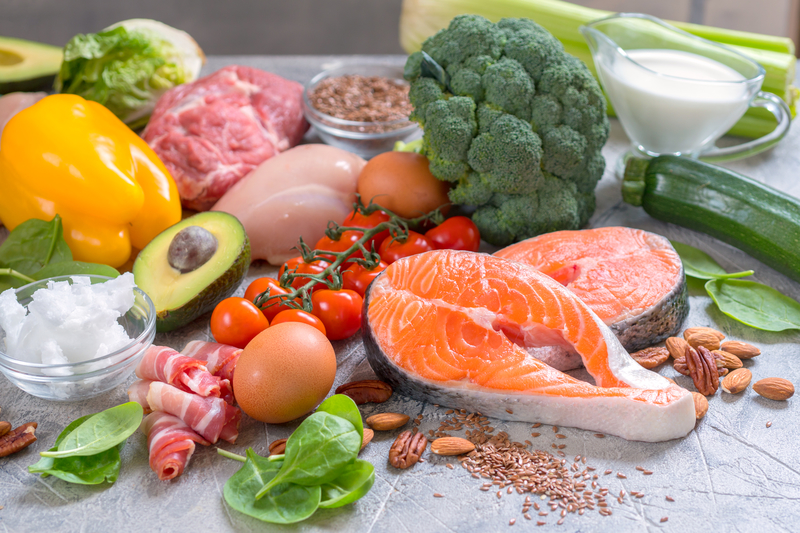How to Start a Low-Carb Diet? (see our beginner’s guide)

So, you’ve decided to start a low-carbohydrate diet, but you aren’t sure how to start a low-carb diet plan. You aren’t even really sure if it’s what you should be doing, but you have finally jumped on the bandwagon. Maybe you know you shouldn’t fear the fat, are still iffy on how much protein you need, but you know for sure carbs are bad.
But are they really?
I wouldn’t go as far as to say carbohydrates are inherently bad; rather much like anything else, there are different ends of the spectrum. For example, foods like asparagus, broccoli, Brussel sprouts, spinach, and celery are low-glycemic index vegetables which fall below 20 carbohydrates per serving. Whereas fruits, breads, pasta, and vegetables like carrots, corn, potatoes, squash, and sweet potatoes rank a little higher on the glycemic index, so they may not fit as well on a low-carbohydrate diet.
I am all for having your cake and eating it too, but I would prefer to bake my own than buy a store-bought variety, which tend to be loaded with artificial ingredients and are heavily processed. Processed foods can typically be found in the center aisles of the grocery store, which is probably where “all” carbohydrates picked up such a bad rap.
If we stick to “good carbs” and limit (or omit) the “bad ones,” a low-carb diet can be a great option for most folks. There is no one-sized-fits-all meal plan, but studies have shown time and time again that lower carbohydrate diets are favorable for a slew of health concerns, including but not limited to, cardiovascular disease, elevated blood fats (e.g., LDL cholesterol and triglycerides), high blood pressure, and increased body composition (obesity).
Furthermore, research has shown when you avoid sugar and starches, your blood sugar tends to stabilize, and the levels of the fat-storing hormone insulin drop. This allows your body to increase fat burning and also makes you feel more satisfied, so you eat less. This in turn can cause increased weight loss.
Whether you are going to just jump right in with both feet and kick carbs to the curb, or you are going to slowly decrease carbs a little at a time, a bit of prep work can make you more successful when you start a low-carb diet.
What are the Other Macros?
The first and probably most important step is determining how you are going to work with the other macros. Are you going to have an equal balance of carbohydrates and protein, are you going to go higher in protein and limit your fats, or are you going more ketogenic with higher fats, limited protein, and very low carb?
There is no wrong or right answer here, as there are benefits to each of these options. It really boils down to what you can incorporate into your lifestyle and what you will be consistent with (and, of course, taking into consideration any allergies or dietary needs you may have as well).
As glamorous as it sounds to be able to eat copious amounts of fats, that is just not something I can get behind, so for me personally, my diet consists mainly of a high protein, lower fat, and low-carbohydrate diet. My body seems to work best, and I can check off all the boxes, such as hunger, energy, and cravings. I know my meal plan is solid and doing the best for my body when I am not hungry, when my energy levels are at peak performance, and when I don’t have cravings.
You Need to Get Rid of the Bad Carbs
Once you have decided on what type of low-carb meal plan you are going to incorporate, you should work on completing a kitchen makeover. I don’t mean hiring a demolition crew and redecorating. I mean to get rid of everything in your kitchen that isn’t in line with your healthy eating plan. Rid yourself of the processed foods, anything that contains artificial ingredients, and things that may be “trigger”’ foods for you.
Check all of your secret hiding spots for candy, chocolate, and things you sneak when nobody is looking (or when the kids go to bed). I am not saying you can’t occasionally indulge in these things, but the old adage of “out of sight, out of mind” usually works best. I know for myself, if I know there are a few Twizzlers somewhere in the house and I had a rough day or have the munchies, those are probably where I go rather than to the produce drawer. I am only human, just like you. 😉
How to Start a Low-Carb Diet: The Basics
Which Veggies Have the Least Carbs?
I will share a super simple rule I learned. “Vegetables growing above ground are usually low carb and can be eaten freely.” On the other hand, vegetables growing below ground contain more carbs, so you’ll want to be more careful with them (think potatoes).
There are some exceptions to this rule, but basically, use your best judgement.
The following are my go-tos when you start a low-carb diet. I have broken them down by net carbs per 100 grams (3½ ounces).
- Cauliflower – 3 g
- Cabbage – 3 g
- Avocado – 2 g
- Broccoli – 4 g
- Zucchini – 3 g
- Spinach – 1 g
- Asparagus – 2 g
- Kale – 3 g
- Green beans – 4 g
- Brussels sprouts – 5 g
What Fruits Can You Eat on a Low-Carb Diet?
You may have heard that most fruits contain a ton of sugar, but to be honest, that is a natural source of sugar, and more importantly, they’re packed with fiber and lots of phytonutrients. That doesn’t always make it “low carb,” but don’t overlook the good because of your fear of carbs. My rule of thumb with fruits is that most berries are basically low carb, but be mindful of portion sizes. It can be very easy to toss back a couple handfuls of blueberries, especially when they are fresh and you pick them yourself.
On a low-carb diet (50 – 100 grams per day), you may be able to squeeze in two or three fruits a day, if that is your biggest source of carbs.
The following are some of my top choices:
- Raspberries – Half a cup (60 grams) contains 3 grams of carbs.
- Blackberries – Half a cup (70 grams) contains 4 grams of carbs.
- Strawberries – Eight medium-sized (100 grams) contains 6 grams of carbs.
- Plum – One medium-sized (65 grams) contains 7 grams of carbs.
- Clementine – One medium-sized (75 grams) contains 8 grams of carbs.
- Kiwi – One medium-sized (70 grams) contains 8 grams of carbs.
- Cherries – Half a cup (75 grams or about 12 cherries) contains 8 grams of carbs.
- Blueberries – Half a cup (75 grams) contains 9 grams of carbs.
- Cantaloupe (melon) – One cup (160 grams) contains 11 grams of carbs.
- Peach – One medium-sized (150 grams) contains 13 grams of carbs.
Which Nuts are Best for Low-Carb Diets?
Most often we think of nuts only in terms of healthy fats, but these tiny treasures can really pack in some carbohydrates and are very easy to overeat. Have you ever been to a party where there are bowls of mixed nuts? Everyone always has their favorite, and for some reason, in my experience, all that’s ever left at the end of the night are the Brazil nuts? After checking out my top low-carbohydrate options, some of you may be changing your tune.
- Pecan nuts – one (100-gram) serving contains 4 grams of net carbs.
- Brazil nuts – one (100-gram) serving contains 4 grams of net carbs.
- Macadamia – one (100-gram) serving contains 5 grams of net carbs.
- Hazel nuts – one (100-gram) serving contains 7 grams of net carbs.
- Walnuts – one (100-gram) serving contains 7 grams of net carbs.
- Peanuts – one (100-gram) serving contains 8 grams of net carbs.
- Almonds – one (100-gram) serving contains 9 grams of net carbs.
Our Favorite Low Carb Recipes
If you are looking to start a low-carb diet and aren’t quite sure how to piece it all together, we have some excellent recipes on our blog to help get the proverbial ball rolling:
How to Start a Low-Carb Diet: A Recap
Not sure you can jump in with both feet into the low-carbohydrate lifestyle, or maybe you are still scratching your head and wondering Are Low Carb Diets Healthy? Coach Tim has those answers for you.
Perhaps Slow Carb is a little more your speed. Check out what Coach Tim had to say about this trendy new meal plan that is said to have people dropping 20 pounds of fat in 30 days…without doing excessive exercise.
If you are trying to figure out how to start a low-carb diet or any of the above-mentioned programs, or any program for that matter, drop a comment below and we will help you out!







